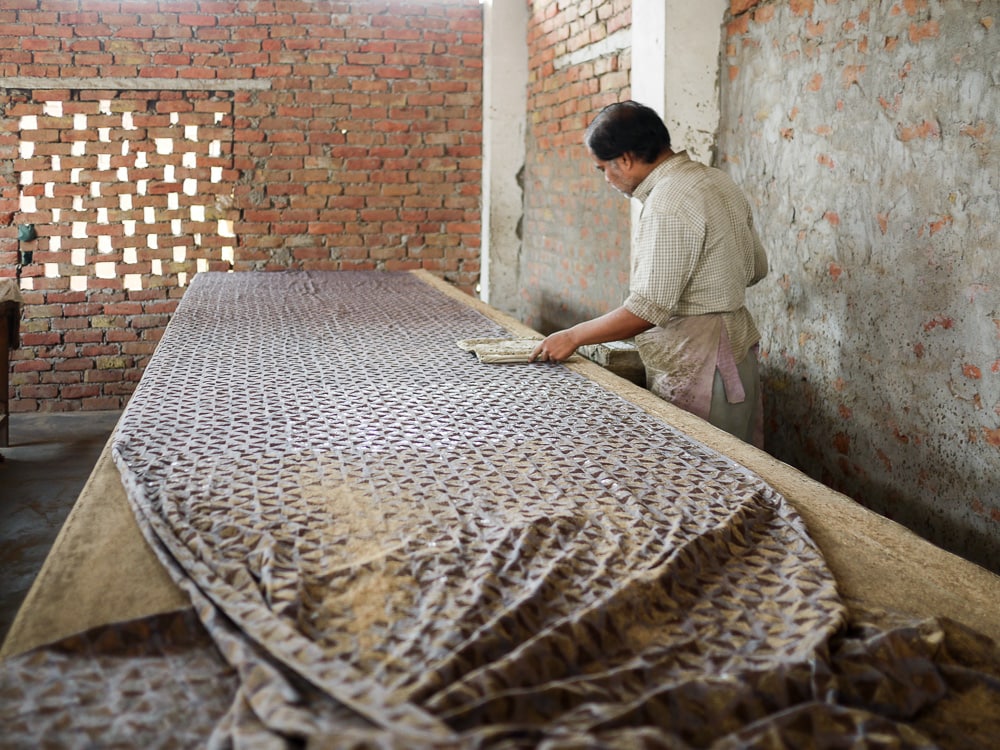Article: The Road to Bagru Printing

The Road to Bagru Printing
The road to Bagru printing was lengthy and quite unconventional. Adaara met Bagru impromptu; it was an accidental encounter that led to a road of discovery, fusion and enlightenment. About 3-4 years ago, when they were travelling through the Pink City of Jaipur, listening to the legends and myths of the forts and temples, they landed upon the majestic Amer Fort. With its enriched artistry and history, Amer Fort was adorned with vegetable dyes. On enquiring more about those natural dyes, they came to know about Bagru printing, a technique of printing done using these dyes. They also found out that the trail behind the fort led them to a village that still captivates the magic of this art, the village where the artisans of this craft lived. And that’s how they found their way to Bagru printing.
Bagru printing is a centuries old traditional art of hand-block printing coming from the land of Rajasthan. This ancient art was introduced to the world by the ‘Chhipas’ of Bagru village, who migrated to Bagru from Alwar centuries ago. This little village is famous for the artisans who have kept the three centuries-old technique of printing still alive. Bagru printing involves vibrant colours, intricate motifs and patterns, and skillful workmanship. The Bageecha collection of Adaara showcases the traditional art of Chhipas; the skills, creativity and craftsmanship of the proficient Bagru artisans from Jaipur. Adaara presents to you the designs that resonate with the heritage of India in the contemporary world of fashion and trends.

There are two main types of Bagru printing techniques. The first is Direct Dye Printing, in which a printer first dips the wooden printing block in the dye tray before pounding the centre of the block onto the fabric with his or her fist. This pattern is repeated to align the blocks by the eye. The second technique is called the ‘Dabu’ style in which the artisans create coloured motifs on a dark background using mud-resist painting. Bagru printing is also known for the use of two main vibrant colours that form the identity of this art: a red color outline called ‘Began’ and a black color called ‘Syahi’. There are many intricate motifs and designs that are used in Bagru Printing, such as Aath Kaliya, Bankandi, Bada Bunta, Hanjura, Bewada, Hara Dhaniya, Chopard and Kamal.
Adaara uses the age-old recipes of vegetable dye colours to curate intricate prints on the natural fabrics. Bagru is known for its conventional printing technique using ginger. The designers at Adaara present to you the craft of Bagru printing, but with a touch of Adaara. The motifs are beautifully orchestrated using vegetable dye in the designs of mushroom and leafs using the block printing technique, rather than the conventional ginger technique. The Bageecha collection of Adaara is a perfect blend of our rich culture and heritage with our modern trends and style. Living on the sleeves of their Kaftans and tunics, is the art of the intricate motifs of Bagru printing.


The human touch of Bagru Printing is what makes it special. The intricate designs printed by the artisans have a special appearance to the prints that you wouldn’t find in a machine print. The craft of hand-block printing is an art, an expression of the culture and heritage of India. In the present era of environmental crisis, sustainable indigenous art and craft need to be protected more than ever. The rampant globalization is manifesting a threat to the indigenous and local artisans of India. With the evolving digital printing techniques, these artisans are on the verge of losing their livelihood. This age old heritage of printing is about to disappear if we do not show our support to this ancient art of India. Bagru printing is a beautiful expression of nature on fabric, which Adaara is trying to cherish and preserve.


